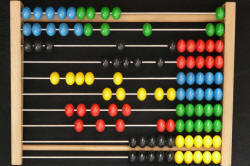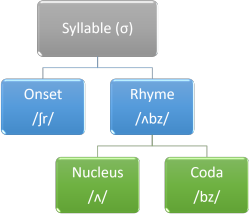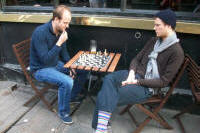The syllable and phonotactics

Syllabification is to do with how we chop up words. If we
can't analyse the syllable, it becomes very difficult to deal with
things like word and sentence stress and almost impossible to
transcribe accurately what people say.
In addition to understanding phonemic analysis at the level of
vowels and consonants, we need to know how these elements combine to
make comprehensible speech rather than just a series of noises.
The second concern of this guide is to outline the nature of English phonotactics. This refers to what is and is not allowable in English in terms of how syllables may be constructed.
For the purposes of the first part of this guide, we shall define
a syllable as a unit of pronunciation
having one vowel sound, with or without surrounding consonants.
As we shall see, there are exceptions.
 |
Counting syllables |
Most people are able to count how many syllables there are in an
individual word, even if they would be hard put to define exactly
what is meant by the term 'syllable'. They do this, when asked,
often by tapping out the numbers on a table or by humming the sound
of the word. Inadvertently, they are betraying just how
crucial syllable structure is to phrasing and rhythm in the
language.
Roach (2009: 56), however, notes:
As a matter of fact, if one tries the experiment of asking English speakers to count the syllables in, say, a recorded sentence, there is often a considerable amount of disagreement.
This is because, in more extended speech than a single word or short phrase, what is perceived is often at odds with what one knows about the sentence and lexical structures. Even single words, providing they are sufficiently polysyllabic, may cause problems and counting the number of syllables in a word such as denationalisation requires a little concentration. There are seven when the word is pronounced carefully and in isolation [/ˌdi:.ˌnæ.ʃə.nə.laɪ.ˈzeɪʃ.ən/] but likely to be fewer if the word appears in a string because the fifth, which is unstressed, is often elided. Note, by the way, the convention of placing a '.' between syllables in transcriptions.
 |
Syllable structures (or shapes) |
Here, we will be using the term syllable structure but other analyses prefer the term syllable shape to describe the same phenomena. They are functionally synonymous.
Following Roach (op cit.) we will focus on four kinds of syllables and their natures:
- Minimal syllables
These are the simplest (and quite rare). They usually consist of a single vowel or diphthong. Examples are:
or transcribed as /ɔː/
a transcribed as /eɪ/ or /ə/
uh? often transcribed as /ə/ or /ʌ/
sh! transcribable as /ʃ/
A simple way of representing this structure is with V – the syllable consists only of a vowel – or C – the syllable consists only of a consonant. One transcription of the second example above (a) would be represented as VV because it is formed from a diphthong. - Onset-only syllables
These have one or more consonants before the vowel. Examples are:
go /ɡəʊ/
be /biː/
say /ˈseɪ/
dry /ˈtraɪ/
hay /heɪ/
try /draɪ/
etc.
The consonant(s) before the vowel are referred to as the syllable Onset.
A simple way of representing this structure is to with CV – the syllable consists only of a consonant and a vowel (be). The first example above (go) and the third (say) would be represented as CVV because they both have a diphthong following the consonant, and the fourth and last examples above (dry and try) would be represented as CCVV because they have two consonants forming the Onset and a diphthong following those. - Coda-only syllables
These have no Onset but have a consonant or consonants at the end (referred to as the Coda). Examples are:
eat /iːt/
ask /ɑːsk/
angst /æŋst/
of /ɒv/
etc.
A simple way of representing this structure is to with VC – the syllable consists only of a vowel and a consonant. The second example above (ask) would be represented as VCC and the third (angst) as VCCC. - Syllables with Onset and Coda
Examples are:
but /bʌt/
start /stɑːt/
bus /bʌs/
shot /ʃɒt/
hurt /hɜːt/
etc.
A simple way of representing this structure is to with CVC – the syllable consists of a consonant, a vowel and another consonant. The second example above (start) would be represented as CCVCC and the last example (hurt) as CVCC.
When an Onset or Coda contains more than one consonant, it is described as complex.
The system looks like this, taking the syllable shrubs
[/ʃrʌbz/] as our example because it has both a complex consonant
cluster onset (/ʃr/) and a similarly complex coda (/bz/):

The structure is, therefore, CCVCC.
The Rhyme is so called because it is this part of the syllable
which allows a poetic rhyme as in hatch, match and dispatch,
for example. You may see it spelled as Rime in US texts.
In our example, it allows a rhyme with nubs or clubs
(/nʌbz/ and /klʌbz/) because the same three sounds are present: /ʌ/,
/b/ and /z/.
In some analyses, e.g. Roach (op cit.), the Nucleus is referred
to as the Peak. Here we are following Zec (in de Lacy (2007:
171)).
In some analyses, too, especially of languages other than English,
the system is seen branching to the left rather than, as here, to
the right so the Onset and Nucleus are considered together as the
Body and the Coda stands to the right.
Other analysts, incidentally, doubt the whole existence
of the syllable as a unit of analysis. Oh, well.
 |
Phonotactics |
The term comes from the Greek and refers to the arrangement of
sounds in a language. In other words, it looks at what is
possible in terms of the combinations of V and C.
The possible number of ways to arrange 24 consonants in two-sound
combinations or clusters is 576 but no language on earth will allow
anything like that number of combinations. If we consider
three-sound clusters, the number of possibilities rises to 13,824 but the
most flexible and liberal of languages, such as Russian in this respect, will not
exhibit more than a tiny fraction of all the possible combinations.
For example, there are no English words in the Chambers 20th Century
Dictionary which begin with shm. There
are, however, some which begin with schm such as
schmelz, schmooze and schmuck (all of which are loan
words from German or Yiddish and none of which causes English
speakers any pronunciation trouble). English football
commentators had little difficulty pronouncing the name of the
Danish goalkeeper Schmeichel. Nevertheless, the combination of
/ʃ/ and /m/ as the onset of a syllable is not allowed by the
phonotactic rules of English and most native speakers would reject a
word like shmig without a second thought.
 |
Possibilities |
After both players have moved three times in a game of chess,
there are estimated to be nine million possible alternative moves
that can be made. After four moves each, the number runs into
the hundreds of billions. English, while it has a complex and
varied syllabic structure, does not get close to that number but it
does get closer than many languages.
Depending slightly on how you count, there are 21 vowel sounds in
English which in theory could combine with any of the 24 consonant
sounds in any order. The number of possible syllable
structures is, therefore, truly astronomical.
However, as we shall see only some of the possible combinations are
acceptable in English.
In English, we can have:
| Syllable structure | Example | Transcription | Syllable structure | Example | Transcription | |
| V | eye | /aɪ/ | VCC | ink | /ɪŋk/ | |
| CV | bay | /beɪ/ | CVCC | husk | /hʌsk/ | |
| CCV | fry | /fraɪ/ | CCVCC | crust | /krʌst/ | |
| CCCV | scree | /skriː/ | CCCVCC | strings | /strɪŋz/ | |
| VC | in | /ɪn/ | VCCC | amps | /æmps/ | |
| CVC | meat | /miːt/ | CVCCC | camps | /kæmps/ | |
| CCVC | treat | /triːt/ | CCVCCC | tramps | /træmps/ | |
| CCCVC | screech | /skriːtʃ/ | CCCVCCC | strengths | /streŋθs/ |
Rarely, we can also allow syllables ending in CCCC (such as in
sevenths).
It is, incidentally, possible to see why a writing system that
represents syllables rather than individual phonemes is not suitable
for English (or most Indo-European languages). The number of
graphemes (individual symbols) that would be required is simply too
large to be usable. Other languages, for example, Japanese,
which makes do with a much smaller set of possible syllable
structures (mostly CV or CVC) are written using a syllabic system.
The Japanese writing system, kana, contains forty-six characters,
each representing syllables rather than individual sounds and
another, katakana, has the same number of syllables to render loan
words in Japanese.
 |
General rules |
There are some other general rules concerning what is and is not allowed in English:
- No syllables containing more than three consonants may occur in the initial position in a word. We can have strew but not strpew, for example.
- Any syllable can begin and end with a vowel.
- No syllables can end with more than four consonants (and more than three is vanishingly rare). We can allow sevenths (/ˈsevnθs/) with four final consonants in a cluster but that is the limit.
- No syllable may start with /ŋ/ (apart from rare loan words and names such as Ngaio [from Maori], which should be pronounced as /ŋ.ɡaɪ.əʊ/ but which most English speakers will render as /n.ɡaɪ.əʊ/). Additionally, /ʒ/ in that place is very rare (most being French loan words such as gendarme [/ˈʒɒn.dɑːm/]).
- No word may end with a syllable ending
in /h/, /w/ or /j/.
So we allow:
/w/ initially as in want [/wɒnt/]
/w/ medially as in homeward [/ˈhəʊm.wəd/]
but not /w/ finally as in endow because that is pronounced as /ɪn.ˈdaʊ/ with a final vowel
and we allow
/h/ initially as in hut [/hʌt/]
medially as in dishearten [/dɪs.ˈhɑːt.n̩/]
but not finally as in verandah because that is pronounced as //və.ˈræn.də/ with the /h/ unpronounced
and we allow
/j/ initially as in yacht [/jɒt/]
/j/ medially as in beyond [/bɪ.ˈjɒnd/]
but not finally as in silly because that is pronounced as /ˈsɪ.li/.
 |
Initial consonants |
There are also some useful generalisations we can make about initial-position consonant clusters (i.e., those consisting of more than a single consonant).
- The consonant /s/
is followed by a limited range of single consonants. In these cases, the /s/ is referred to as pre-initial and what follows as the initial consonant. The pre-initial /s/ may be followed only by:- /p/ (as in spend [/spend/]
- /t/ (as in step [/step/])
- /k/ (as in skip [/skɪp/])
- /f/ (as in sphere [/sfɪə/)
- /m/ (as in small [/smɔːl/])
- /n/ (as in snip [/snɪp/])
- /l/ (as in slip [/slɪp/])
- /w/ (as in swing [/swɪŋ/])
- /j/ (as in suit [/sjuːt/])
This is becoming rare in Modern English and normally transcribed as /suːt/ rather than /sjuːt/.
It follows, therefore that the following twelve possible
combinations are not permitted in
English: /sb/, /sd/, /sɡ/, /sθ/, /ss/, /sʃ/, /sh/, /sv/, /sð/
/sz/, /sʒ/ and /sŋ/.
The reasons for this lie not, as many imagine, in the difficulty of
pronouncing the combinations but in the historical development of
English. There is no obvious reason why a person who can
pronounce skin satisfactorily cannot pronounce sgin.
For example, in Italian /sf/ and /sɡ/ both occur and /sz/, /sd/ and
/sb/ are common in many other languages. The Swedish for
Sweden is Sverige and pronouncing Sri Lanka (/ˈʃriː.ˈlæŋk.ə/) is also not difficult
for most English speakers.
In many analyses only /s/ + /p/, /t/ and /k/ are considered as
having pre-initial /s/. The other combinations are described
as having /s/ followed by a post-initial consonant. For
teaching purposes, this doesn't matter, of course, but it should be
noted that the combinations of /s/ + /p/, /t/ and /k/ are very
common in English and forbidden in many languages.
- Initial three-consonant clusters with a
pre-initial /s/
are also a restricted set. We can only have:- /sp/ + /l/ (as in splay [/spleɪ]/)
- /sp/ + /r/ (as in spray [/spreɪ/])
- /sp/ + /j/ (as in spurious [/ˈspjʊə.rɪəs/])
- /st/ + /r/ (as in string [/strɪŋ/])
- /st/ + /j/ (as in, in some people's production, stew [/stjuː/] although others may use /stuː/)
- /sk/ + /l/ (as, just about only, in sclerotic [/sklɪə.ˈrɒ.tɪk/])
- /sk/ + /r/ (as in screech [/skriːtʃ/])
- /sk/ + /w/ (as in squeal [/skwiːl/])
- /sk/ + /j/ (as in, in some people's production, skew [/skjuː/] although others may use /skuː/)
Of these nine possibilities, /sk/ + /l/ is very rare, although it appears in a number of Scots dialect words (such as sklent [look sideways or suspect]), and /st/ + /j/, /sp/ + /j/ and /sk/ + /j/ only occur regularly in some varieties, notably British English when, e.g., student is pronounces as /ˈstjuːdnt/, spume as /spjuːm/ and skew as /skjuː/.
- The occurrence of post-initial consonants in
English
These are the consonants which can occur in the second position and the ones in question are: /l/, /r/, /w/ and /j/. Their use is also restricted./l/ only occurs in combination with /r/ only occurs with: /w/ only occurs with: /j/ only occurs with: - /p/ (play [/ˈpleɪ/])
- /k/ (clay [/kleɪ/])
- /b/ (black [/blæk/])
- /ɡ/ (glum) [/ɡlʌm/])
- /f/ (flab [/flæb/])
- /s/ (slab [/slæb/])
- /p/ (pray [/preɪ/])
- /t/ (tray [/treɪ/])
- /k/ (cry [/kraɪ/])
- /b/ (break [/breɪk/])
- /d/ (drag [/dræɡ/])
- /ɡ/ (grid [/ɡrɪd/])
- /f/ (frog [/frɒɡ/])
- /θ/ (throw [/θrəʊ/])
- /ʃ/ (shrink [/ʃrɪŋk/])
- /t/ (twin [/twɪn/])
- /k/ (quick [/kwɪk/])
- /d/ (dwell [/dwel/])
- /θ/ (thwack [/θwæk/])
- /s/ (swipe [/swaɪp/])
- /p/ (pew [/pjuː/])
- /t/ (tube [/tjuːb/])
- /k/ (cute [/kjuːt/])
- /b/ (beauty [/ˈbjuː.ti/])
- /d/ (duty [/ˈdjuː.ti/])
- /f/ (future [/ˈfjuː.tʃər/])
- /s/ (suit [/sjuːt/])
- /h/ (huge [/hjuːdʒ/])
- /v/ (view [/vjuː/])
- /m/ (mew [/mjuː/])
- /n/ (new [/njuː/])
- /l/ (lewd [/ljuːd/])
Some of these combinations are quite rare (e.g., /θ/ + /w/, with
only three entries in most dictionaries: thwack, thwaite
and thwart, incidentally, according to Chambers.
This means that there are, for example, 17 consonants which cannot,
in English, immediately occur before /l/ in the initial position, 14
which cannot occur before /r/, 18 which cannot occur before /w/ and
11 which cannot occur before /j/ (and /sj/ is rare in some
varieties).
Again, other combinations, which are not permitted for English
syllables, are not unpronounceable. English speakers have, for
example, no trouble with the Welsh name Gwen and there is no obvious
reason why those who can pronounce throw and through could not
pronounce the words with a voiced initial consonant (/ðrəʊ/ instead
of /θrəʊ/) but /ðr/ is simply not allowed in this place.
Only one word in English, taken from Greek, begins /tm/ (tmesis,
referring to the insertion of a word between the constituents of a
compound) and its plural tmeses. The rarity leads
some speakers to pronounce the initial cluster as /təm/.
Most of the combinations forbidden in English appear in other languages.
German allows /pf/, French /vr/, Greek /ɡn/, /vl/, /tm/ and /vɡ/, Czech/tk/
and so on.
 |
Final consonants |
We can also identify phonotactic rules for final consonants in
English. The final morpheme of many words in English can be
described as a vowel plus a final consonant preceded by another to make a cluster
or a final consonant followed by another to form the cluster.
For example, in forming plurals and verb inflexions such as past
tenses and other structures, English has the final consonant
followed by /s/ (as in lots [/lɒts/, /z/ (as in lads [/lædz/]),
/t/ (as in sacked [/sækt/]) or /θ/ (as in seventh [/ˈsevn̩θ/]).
In these cases, the /s/, /z/, /t/ and /θ/ are the only four
allowable post-final consonants.
Pre-final consonants can be identified because they do not perform
these grammatical functions and there is no overlap between the
classes apart from the ubiquitous /s/ which appears post-finally in
inflexions and pre-finally in other environments.
- All consonants can come in the final position of a word except /h/, /w/ and /j/. See above for examples.
- /r/ only comes in the final position in what are called rhotic accents in which the sound is always pronounced. In RP or BBC English the word father is transcribed as /ˈfɑːð.ə/ but in AmE it is /ˈfɑːð.r̩/, for example.
- There are five post-final consonants appearing in clusters.
/s/, /z/, /t/, /d/ and /θ/ are the only ones which can follow the final consonant as in, e.g.:
tasks, heads, packed, tabbed, fifth (/tɑːsks/, /hedz/, /pækt/, /tæbd/, /ˈfɪfθ/)
So, formulations such as pasm, kopf etc. are not allowed although they are in many languages.
The ending sm which occurs in, e.g., socialism and chasm is generally pronounced as /zəm/ rather than /sm/. The /m/ in this case is not classed as post-final (see next). - There are five pre-final consonants appearing in clusters.
/m/, /n/, /ŋ/ /l/ and /s/ are the only ones which can precede the final consonant. For example:
lumps, banks, ringed, belt, last (/lʌmps/, /bæŋks/, /rɪŋd/, /belt/, /lɑːst/)
Similarly, formulations of sounds such as glanb, fodg etc. are not allowable as they may be in other languages. - A few words in English end in clusters of four consonants and these cause many learners real trouble. Examples are glimpsed (/ɡlɪmpst/) and texts (/teksts/). See, however, the next point.
- Native speakers routinely simplify final consonant clusters,
especially in rapid speech so it is unnecessary to trouble learners
with the full pronunciation of words like products or
camped because the 't' and the 'p' are not usually
sounded by native speakers (so we have /ˈprɒ.dʌks/ not /ˈprɒ.dʌkts/
and /kæmt/ not /ˈkæmpt/).
The middle consonant in clusters such as /kts/, /mps/, /mpt/, /nts/, /ndz/ and /skt/ is usually left out or sounded very weakly. Examples are:
impacts which can be pronounced as /ɪm.ˈpækts/ or /ɪm.ˈpæks/
dumps which can be pronounced as /dʌmps/ or /dʌms/
dumped which can be pronounced as /dʌmpt/ or /dʌmt/
pints which can be pronounced as /paɪnts/ or /paɪns/
funds which can be pronounced as /fʌndz/ or /fʌnz/
tasked which can be pronounced as /tɑːskt/ or /tɑːskt/
That is helpful for teaching purposes, especially for learners whose first languages do not allow or allow a more limited range of final consonant clusters.
The troublesome /ð/ in clothes is also often ignored by native speakers and learners can take the same route (say /kləʊz/, not /kləʊðz/. Nobody will misunderstand and few would notice.). - In BrE, the 'r' in words like marks (/mɑːks/), carts (/kɑːts/) and lords (/lɔːdz/) is not sounded so these are, in fact, two-, not three-consonant clusters.
- Finally, only one word and a few derivatives of it, in English ends in 'mt': dreamt (/dremt/).
 |
Phonotactic rules and implications for teaching |
You may well be wondering why a site mostly concerned with
teaching and learning English takes the trouble to explain all this.
There are implications for teaching because phonotactic rules are
extremely language specific and also not something of which learners
of English (or their teachers) may even be aware.
What results is that learners will attempt, often, to apply the
rules of their first language(s) to English and that may have
unpredictable results (most of them errors).
Simply knowing what syllable structures and natures are allowed in
English and what are rare or forbidden altogether will direct you to
some useful areas of pronunciation practice but there's more to it
than that.
The following are just a few examples with a summary at the end.
Some knowledge, however incomplete, of what syllable structures are
permitted and where they may fall in your learners' first
language(s) will be helpful in planning what to teach, where to lay
the focus and, just as importantly, what you can safely assume is
familiar already.
- In Spanish:
- /s/ plus a consonant is not permitted at the beginning of
words. The combination may occur elsewhere in words so the problem is
not one of pronouncing the sounds, it is one of assuming that
English follows the same rules.
The result often is that Spanish speakers will insert a sound (usually /e/) before the consonant cluster and pronounce, for example, strike as estrike and school as eschool (/estraɪk/ and /eskuːl/). - In Arabic:
- no consonant clusters appear at all, except in some rare loan words. The tendency, therefore for Arabic speakers to insert a vowel epenthetically into English words is understandable so a word like scratch may be pronounced as sekaratesh. Arabic is a macro-language or language group, properly, and many varieties of it are not mutually comprehensible. They exhibit a variety of phonotactic rules.
- In Farsi (a Persian language):
- initial consonant clusters do not occur and the same tendency will be apparent with e.g., spin rendered as sepin.
- In French:
- it is permissible to have initial consonant clusters of /blj/,
/klj/ or /plj/ but they are disallowed in English.
Speakers of French may be tempted, therefore, to pronounce
clue as /kljuː/ or blue as /bljuː/ and that
contributes to a foreign accent, of course.
French also allows /vr/ as the onset of a syllable (as in vrai) and that is forbidden to English. The result can be that /v/ in the initial position may actually be pronounced /vr/.
We have seen, above that French also allows /ʒ/ in the initial position of a syllable so speakers of French may be tempted to pronounce, e.g., zoo as /ʒuː/ rather than /zuː/ and even shoe as /ʒuː/ rather than /ʃuː/. - In Chinese:
- Chinese only allows a very restricted set of clusters and,
for example, all the ones in the word clusters (/kl/, /st/
and /rs/) are forbidden.
The tendency, until speakers of Chinese languages have mastered
consonant clusters in English, is to insert a vowel, often
something like a schwa or /e/ between the elements of many
clusters. The result is that a word like screw
may be rendered as sekeru.
Additionally, and the language has this in common with, e.g., Thai, there are no final consonants barring /ŋ/ in most dialects. The result is often that speakers of these languages will simply fail to produce final consonants at all. This obviously affects issues such as the plural and 3rd-person 's' and regular past-tense endings.
Final consonant clusters, which may, in English, be made up of up to four consonants are even more problematic. - In Japanese:
- no consonant clusters occur except (and in a restricted way)
in the middle of words. Loan words from English into
Japanese are altered in their pronunciation to make them, to the
uninitiated, unrecognisable. The word beer, for
example gets an added vowel to conform to Japanese phonotactics
and becomes biiru. Similarly, story may
be rendered as sutori and so on.
Even in the middle of words, where consonant clusters are permitted, Japanese phonotactic rules mean that any consonant following a nasal must be a voiced consonant so, e.g., /nd/, is allowed but /nt/ is forbidden and /mb/ is allowable but not /mp/. This leads to multiple mispronunciations of words like untie, empty and so on. - In Italian:
- it is not possible to have the consonant clusters of pl/ or
/kl/ and they do not occur in native Italian words.
Italian speakers may have difficulty pronouncing and remembering
the spelling of words like comply or unclear.
Very few Italian words end with consonants (and they are often abbreviations or loan words from other languages). Syllables with consonant-cluster codas will be very challenging for most Italian speakers to produce and many will insert a vowel at the end (often a schwa) resulting in the recognisable Italian accent in English. - In German:
- the initial consonant /ʃl/ is permitted and, indeed, common
(as in schlank) but it does not exist in English.
German speakers may produce it in English instead of /sl/.
German also allows /pf/ in the initial position and elsewhere (as in Pfad and Kopf) but that is another forbidden combination in English in any syllable at all so its production leads to errors. - In Greek:
- /pn/ and /ps/ are both allowed in the Onset to a syllable but English forbids them (and changes the pronunciation of, e.g., pneumatic and psychotic to conform). Greek speakers may assume that words spelled with 'ps' or 'pn' at the beginning may be pronounced fully. The same applies to words beginning 'gn' such as gnostic. Greek allows no fewer than 32 two-consonant clusters at the beginnings of words which are forbidden in English.
- In Russian:
- because of the gradual loss of short vowels, many initial clusters are permitted which in English are forbidden. These include /pt/, /bd/, /tk/, /kt/ a /gd/, for example. While this makes it challenging for English speakers to pronounce Russian the reverse effect is that Russian speakers may deploy these, to them, common clusters in English words so, e.g., cab driver may be pronounced with a single central consonant cluster and a final /r/ (/ˈkæbd.raɪ.vər/) rather than the normal English pronunciation which is to assimilate the /b/ into /p/ and produce /kæp ˈdraɪ.və/ or simply to elide the /b/ altogether.
So, in summary, the phonotactic rules in various languages have three major effects on the learners' production of English and result in an identifiable foreign accent which may betray the speaker's first language:
- Syllable shapes and clusters which are forbidden in the learners' first languages will be difficult to acquire in English and may be substituted by a shape and structure which is more familiar.
- Consonant and consonant cluster codas, such as /kt/ and /dz/ in particular which are not allowed in the learners' first languages may be ignored altogether.
- Syllable shapes and clusters which are forbidden in English but allowed in the learners' first languages may be inserted into English with a resulting foreign accent. In extreme cases, learners may not be comprehensible at all.
 |
Syllabic consonants |
| /ðə ˈbætl̩ əv ˌwɔː.tə.ˈluː/ | The Battle of Waterloo |
We started this guide by defining a syllable as a unit of pronunciation having one vowel sound, with or without surrounding consonants and noted there that there are exceptions. Here they are.
If you look at the transcription above of The Battle of Waterloo,
you can see a small dot below the /l/ of /ˈbætl̩/. This is the
conventional way of denoting a syllabic consonant. The reason
is that, although in careful speech, the word battle might be
transcribed as /ˈbæt.əl/ with a schwa between the /t/ and /l/
sounds, in rapid speech this is often lost and the /l/ stands alone
as the syllable.
Some transcriptions might also raise the schwa to denote a similar
effect: /ˈbætᵊl/.
There are three consonants (ignoring /m/ and /ŋ/, which are marginal
cases affected by features of connected speech) that can stand alone in normal
speech as syllables in their own right although, because there is no
discernible vowel in such syllables, they cannot be stressed.
Here's the list:
- Syllabic /l̩/
- This is the commonest syllabic consonant and occurs
frequently. Examples are:
word transcription in isolation in rapid speech alveolar consonant + /l/ bottle /ˈbɒt.əl/ /ˈbɒt.l̩/ huddle /ˈhʌd.əl/ /ˈhʌd.l̩/ plosive consonants + /l/ couple /ˈkʌp.əl/ /ˈkʌp.l̩/ struggle /ˈstrʌɡ.əl/ /ˈstrʌɡ.l̩/ /n/ + /l/ panel /ˈpæn.əl/ /ˈpæn.l̩/ - Syllabic /n̩/
- This commonly follows alveolar sounds and is slightly rarer in other
cases. Examples are:
word transcription in isolation in rapid speech alveolar plosive + /n/ threaten /ˈθret.ən/ /ˈθret.n̩/ hidden /ˈhɪd.ən/ /ˈhɪd.n̩/ alveolar fricative + /n/ hastening /ˈheɪs.ən.ɪŋ/ /ˈheɪs.n̩.ɪŋ/ frozen /ˈfrəʊ.zən/ /ˈfrəʊ.zn̩/ other consonants + /n/ wagon /ˈwæ.ɡən/ /ˈwæ.ɡn̩/ even /ˈiːv.ən/ /ˈiːv.n̩/ stiffen /ˈstɪf.ən/ /ˈstɪf.n̩/ - Syllabic /r̩/
- This is uncommon in many British varieties of English but
occurs widely in others, including AmE and the accents spoken in
Scotland, the South-West of Britain and East Anglia.
Examples are:
word transcription in isolation in rapid speech AmE mother /ˈmʌð.ər/ /ˈmʌð.r̩/ pillar /ˈpɪ.lər/ /ˈpɪ.lr̩/ Rapid speech (all varieties) preference /ˈpre.fə.rəns/ /ˈpre.fr̩əns/ deference /ˈde.fə.rəns/ /ˈde.fr̩əns/
As was said above, /m/ and /ŋ/ are marginal cases only appearing
in connected speech. For example:
system may be pronounced as /ˈsɪ.stm̩/ rather than
/ˈsɪ.stəm/
A syllabic /ŋ/ is rarer (and transcribed as /ŋ̍/) but occurs when
the -ing ending is reduced in rapid speech so, e.g.:
making may be realised as /ˈmeɪk.ŋ̍/ rather than its
usual pronunciation as /ˈmeɪk.ɪŋ/
Syllabic consonants are common in other languages, too, but may, as in German, be considered substandard or dialect forms. Germanic, Scandinavian and Slavic languages all exhibit syllabic consonants with /l/, /n/ and /r/ and some languages will also use /m/ and even /tʃ/ or /ʃ/ and other consonants this way. The syllabic /ŋ̍/ is common in Cantonese (and may occur in Mandarin) and often produced by its speakers in English, contributing to a foreign accent.
| This is the index of other guides in the in-service pronunciation section. | ||
| the overview of pronunciation | connected speech | consonants |
| intonation | minimal pairs (PDF) | minimal pairs transcription test |
| sentence stress | syllables and phonotactics | teach yourself transcription |
| teaching pronunciation IP | teaching troublesome sounds | verb and noun inflexions IP |
| vowels | word stress | identifying word-stress IP |
| Guides marked IP are in the initial plus section. | ||
References:
de Lacy, P (ed), 2007, The Cambridge Handbook of Phonology,
Cambridge: Cambridge University Press
Roach, P, 2009, English Phonetics and Phonology: A practical
course, 4th edition, Cambridge: Cambridge University Press
